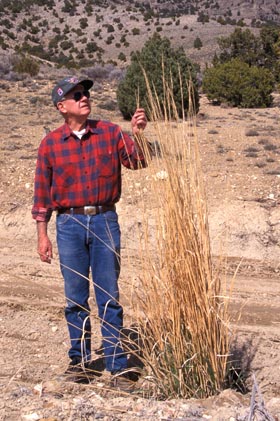Great Basin Wildrye

Common Name(s):
Basin Wildrye
Giant Wildrye
Great Basin Wildrye
Scientific Name:
Leymus cinereus (Scribn. & Merr.) A. Löve
Scientific Name Synonyms:
Elymus cinereus Scribn. & Merr.
Symbol:
LECI4
Description:
Life Span: Perennial
Origin: Native
Season: Cool
Growth Characteristics: An unusually large, robust bunchgrass, usually without rhizomes but with thick tillers. Bunches are 1 to 3 feet in diameter and 2 to 5 feet tall. Starts growth in early spring, seeds mature by August, reproduces from seeds and tillers.
Seedhead: Numerous, erect, awnless spikes up to 10 inches long, dense and compact; 2 to 4 spikelets at each rachis joint, containing 3 to 6 florets; glumes needle-like.
Leaves: Blades coarse, mostly flat up to ¾ inches wide and 1 ½ feet long; sheaths glabrous; leaves rolled in bud; ligules membranous, collar shaped, and up to ¼ inch long; auricles prominent, clasping.
Ecological Adaptions:
Basin wildrye is native to Utah and grows on riverbanks, in ravines, on moist or dry slopes, and on plains at elevations from 4500 on up to the steep mountain slopes at 10,000 feet elevation. It is adapted to areas with 15 to 25 inches of annual precipitation, and is usually found on sites where extra moisture is available, such as riparian sites, ephemeral ponds, swales, and playas.
Basin wildrye is quite fire tolerant. It recovers well, especially if associated shrubs have been killed.
Soils: This grass is adapted to a wide range of soils from clay and silty soils in the deserts to coarse textured, gravelly, and stony soils. It does well in moderately saline soils.
Associated Species: Big sagebrush, western wheatgrass, saltgrass, greasewood, letterman's needlegrass, and fremont geranium.
Uses and Management:
Great Basin Wildrye is not tolerant of heavy grazing, due to the high position of the growth buds (4 to 6 inches above the soil). When managed correctly, it provides an abundance of good, palatable forage during the early spring months, particularly for cattle. Forage is fair for sheep and wildlife. It is relatively unpalatable in the summer. It is especially useful for winter feed for most classes of livestock because it is found above the snowline, but requires a protein supplement.
To best maintain stands of Basin wildrye, it is best grazed during the late fall and winter, when plants are dormant. If grazed in spring or summer, use should be light. Heavy grazing during these times will cause stands to degrade.
Basin wildrye is highly palatable to elk in spring and summer, and highly palatable to mule deer in spring. It provides important cover and winter forage for elk and deer. It also provides habitat for upland game birds and food for songbirds and small mammals.
Basin wildrye provides excellent surface erosion control and soil stabilization and can be a valuable restoration species wherever moisture is adequate. It can be hard to establish due to a lack of highly germinable seed.
Seeds of Basin wildrye were commonly used by many Native Americans in the Great Basin. Roots collected in winter months are stiff, and covered by a spongy, fibrous coating. When cleaned, these were fashioned into hair and cleaning brushes.

